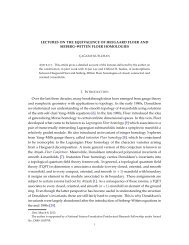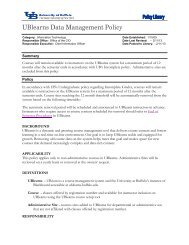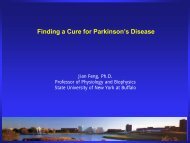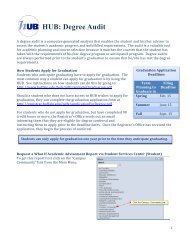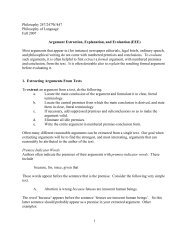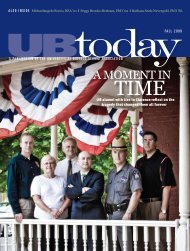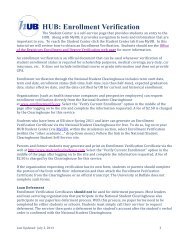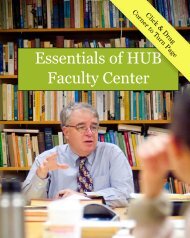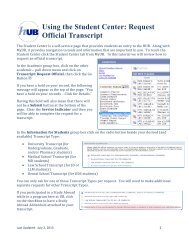A WALK IN THE WOODS - University at Buffalo
A WALK IN THE WOODS - University at Buffalo
A WALK IN THE WOODS - University at Buffalo
You also want an ePaper? Increase the reach of your titles
YUMPU automatically turns print PDFs into web optimized ePapers that Google loves.
(From top) Nick Peterson and SandyGeffner make cordage from dogbanefibers found in the UB forest. Petersonholds, then savors garlic found in thefield, and digs <strong>at</strong> the root of the falseSolomon seal (Maianthemum racemosum),a wild edible th<strong>at</strong> is also usedmedicinally.In addition to his faculty role <strong>at</strong> UB,Sandy Geffner is director of EarthSpirit Educ<strong>at</strong>ional Services, a nonprofitorganiz<strong>at</strong>ion th<strong>at</strong> offers programs onforaging throughout the year. For moreinform<strong>at</strong>ion, go to earthspiritedu.org.22 UBTODAY Fall 2013 www.buffalo.edu/ubtGEFFNER Thankful indeed, and this is something th<strong>at</strong>we share in all of our work and all of our programs.These plants are all alive; these plants work reallyhard to make their fruits, the seeds and theirleaves. In our minds, we always say “thank you”—it’s a healthy way of interacting with the plants.PETERSON A lot of times, we humans considerourselves to be the top of every food chain. There’splenty of other animals th<strong>at</strong> we feel above. Weg<strong>at</strong>her fiddleheads for the sake of gourmet restaurants.The <strong>at</strong>titude is “the leeks and the fiddleheadsare good, so let’s just take them all.”GEFFNER It’s the all-for-us mentality, which is harsh.You bring up a good point regarding the animals.There are clues right out in the field. Especiallywith edibles, if we see animals feeding upon plantsin the field, we have to say, “Maybe,” becausetheir bodies are actually designed to toler<strong>at</strong>e thosem<strong>at</strong>erials th<strong>at</strong> we cannot.PETERSON Here we have dogbane which is absolutelypoisonous but utilitarian.GEFFNER The dogbanes th<strong>at</strong> we’re seeing herecontain a compound th<strong>at</strong> speeds up the heart andis very dangerous. Most cre<strong>at</strong>ures when they seedogbane stay away as a result. They’re not heavilyfed upon <strong>at</strong> all. But we do use dogbane to makecordage. It’s very fibrous, like milkweed, and theymake very good rope. Nick, it looks like you’ve gotthe beginnings of a nice rope there?PETERSON It’s a little bit thin but I was starting toget the idea.GEFFNER Here you’re looking <strong>at</strong> the brambles andthis as you can see is a r<strong>at</strong>her four-sided stem.There are three brambles th<strong>at</strong> are commonlyfound in our area. With this one, do you feel anglesin the stems?PETERSON Yes.GEFFNER Ok, so this would be a blackberry. If youhave thorns with a rounded stem, it’s probablya black raspberry. And when you have pricklesr<strong>at</strong>her than thorns th<strong>at</strong> would be the red raspberry.So we have red raspberry, black raspberry andblackberry as the common brambles. They are allin the genus rubus.Do you recognize this tree?PETERSON I do not. Well, I’ve seen it but I cannotidentify it, let me say th<strong>at</strong>.GEFFNER If you’re ever in doubt with this individual[plant], you see the leaves are elliptical, pointed.On the underside, can you see the orange fluff<strong>at</strong> the base of the main vein? Wh<strong>at</strong> you smell isprussic acid. And no m<strong>at</strong>ter how you look <strong>at</strong> it orhow you describe it, when prussic acid is taken internally,it is a form of cyanide. This is a wild blackcherry. If you really want to make sure, you takea little branch and take off the leaves and you canactually take your fingernail, give it a scr<strong>at</strong>ch andsmell. This is one example of an individual whowill feed you with edible cherries, heal you as acough medicine or kill you if you ingest too much.Be careful—this is poison ivy here. Do you see?PETERSON Poison ivy and the false Solomon seal.GEFFNER The false Solomon seal and the mayappleoffer a good lesson. We should look <strong>at</strong> the poisonivy first. Because when it comes to plants, animals,all aspects of n<strong>at</strong>ure, there’s no good or bad outhere from the n<strong>at</strong>uralist’s point of view. If webreak a leaf or stem, the sap gets on our skin th<strong>at</strong>can cause an outbreak of derm<strong>at</strong>itis. But poisonivy produces fruit in the fall, which is heavily usedby many small animals and a wide range of birds.They depend on the poison ivy for food, and thepoison ivy wants them to e<strong>at</strong> the berries. Th<strong>at</strong>’swhy plants make good-tasting fruits. The fruits gete<strong>at</strong>en and digested and the seeds are dispersed.This is the most functional way of spreading seed,using animals to do th<strong>at</strong> in th<strong>at</strong> way.PETERSON Th<strong>at</strong>’s interesting. Something you mightthink about when you see a particular plant in themiddle of a human landscape and wonder howdid this plant grow up here?GEFFNER Oh my goodness! These are really old, butlook <strong>at</strong> the size of this crop [of mushrooms]. Thislooks like Hen of the Woods, wh<strong>at</strong>’s left of it. Thisis one of the edible fungi. Keeping in mind howcareful we have to be in harvesting the herbs, it’sdoubly so with the fungus. I do a lot of mushroomharvesting. My record is 80 pounds in one year!PETERSON Th<strong>at</strong>’s a lot of mushrooms. How canwe be conscientious collectors when it comes tomushrooms like these?GEFFNER I wouldn’t take them all. When I harvestclumps of these Hen of the Woods, I’d wantthem to reproduce. You harvest them close to theground. If we harvest them properly, we will encouragethe reharvesting of these fruits. And theymay come up year after year in the same place.PETERSON For someone who’s completely new toforaging, wh<strong>at</strong> would you suggest to them aboutwild edibles?GEFFNER No. 1, the best place to begin is always withsomeone who’s connected to th<strong>at</strong> field. Th<strong>at</strong> givesyou a good introduction. No. 2, you get a good fieldguide th<strong>at</strong> will help you identify, then [obtain] thefield guides th<strong>at</strong> take you into your area of interest.The first thing is to learn to recognize. You gofrom there to careful experiment<strong>at</strong>ion, then you’reok. But I don’t recommend th<strong>at</strong> you experimentwith mushrooms! Seriously, th<strong>at</strong>’s something youshould always do with someone who knows.PETERSON So wh<strong>at</strong> is to be gained through thisknowledge or these interests in these wild foods?GEFFNER These pursuits keep us in touch with therhythms and bounty of n<strong>at</strong>ure.



